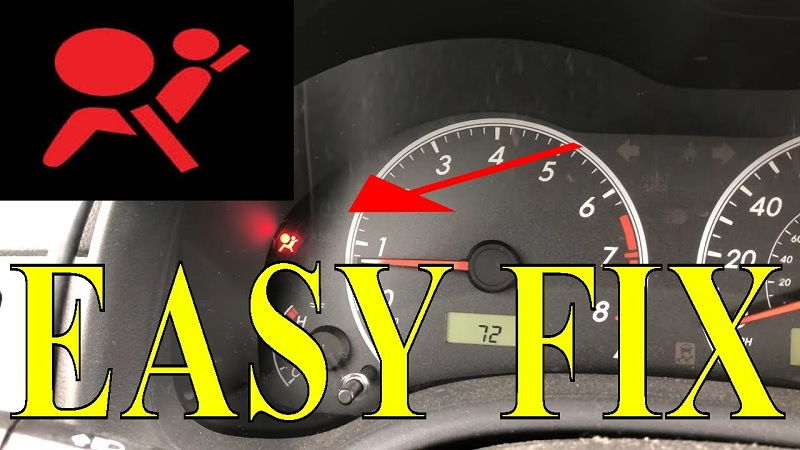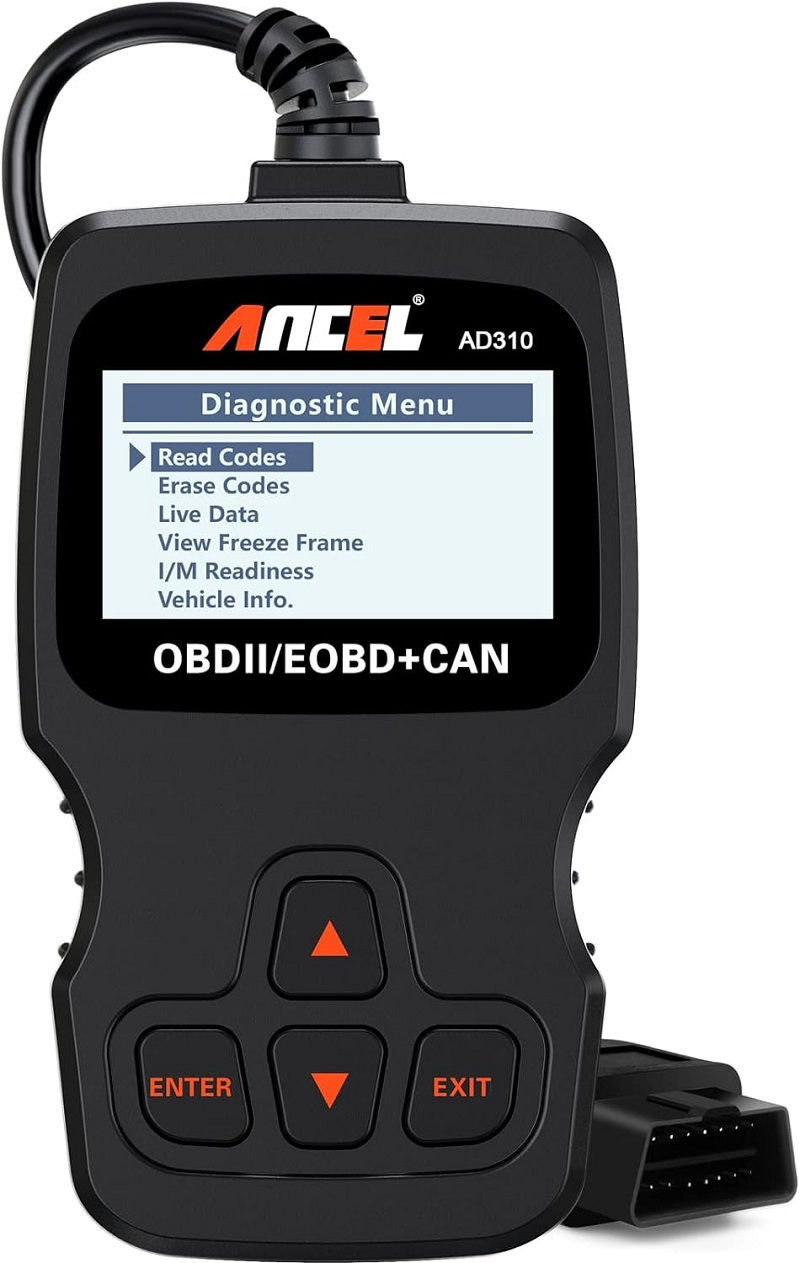This post contains affiliate links. This means I will make a commission at no extra cost to you should you click through and make a purchase [ “As an Amazon Associate, I earn from qualifying purchases.” ]. Read the full disclosure here.
Airbag Warning Light Meaning GuideMechanic.Com When it comes to car safety, the airbag system plays a crucial role in protecting both the driver and passengers in case of an accident.
However, there are times when you may notice that the airbag warning light on your dashboard illuminates, leaving you concerned and wondering about its meaning.
In this comprehensive guide, we will delve into the various reasons why the airbag warning light may come on and what it signifies.
Airbag Warning Light Meaning: Understanding the Airbag System

Modern vehicles are equipped with advanced safety features, and airbags are an integral part of this system.
The purpose of airbags is to provide an additional layer of protection to vehicle occupants during a collision. The system consists of sensors, control units, and airbag modules strategically placed throughout the vehicle.
See Also: Mini Cooper Check Engine Light
When an accident occurs and the sensors detect a sudden deceleration or impact, they send a signal to the control unit.
The control unit then triggers the airbag modules to rapidly inflate, cushioning the occupants and preventing them from striking hard surfaces.
Types of Airbags
There are several types of airbags found in modern vehicles, each designed to protect specific areas of the body:
1. Frontal Airbags: These airbags are located in the front of the vehicle, typically in the steering wheel and dashboard area. They deploy in the event of a forward collision, providing protection for the driver and front passenger.
2. Side Airbags: Side airbags are installed in the side panels of the vehicle’s seats or doors. They deploy during a side impact collision, reducing the risk of injury to the torso and head.
3. Curtain Airbags: Also known as roof-mounted airbags, these deploy from the ceiling area above the side windows. They provide protection for the head and neck during a side impact or rollover accident.
How the Airbag System Works
The airbag system operates on a complex network of components that work seamlessly together to provide quick and effective protection. It involves three main stages: sensing, decision, and inflation.
Sensing: The sensing stage involves the use of accelerometers and other sensors strategically placed throughout the vehicle.
These sensors detect changes in speed and deceleration, allowing them to identify the severity of a potential collision.
Decision: Once the sensors detect a collision or impact, they send signals to the control unit. The control unit then analyzes the data received and determines whether the deployment of airbags is necessary based on predefined algorithms and thresholds.
Inflation: If the control unit determines that airbag deployment is required, it triggers an electric current that passes through a solid propellant inside the airbag module. This causes a chemical reaction, generating a gas that inflates the airbag within milliseconds.
Airbag Warning Light Meaning: Common Causes of Airbag Warning Light Activation

While the airbag warning light is designed to alert you to potential issues with the airbag system, it does not provide specific details about the problem. Here are some common causes that may trigger the airbag warning light:
Faulty Airbag Sensor
One of the primary causes of the airbag warning light activation is a malfunctioning airbag sensor. The sensor’s role is to detect changes in acceleration and deceleration, signaling the control unit to deploy the airbags in the event of a collision.
If the sensor becomes faulty, it may send incorrect signals or fail to send any signals at all. This can lead to the airbag warning light illuminating on the dashboard.
A faulty sensor may be caused by various factors, such as electrical issues, physical damage, or even a buildup of dirt and debris.
Electrical Problems
The airbag system relies on a complex network of electrical connections to function properly. Any disruptions or faults in these connections can trigger the airbag warning light. Electrical problems can occur due to loose connections, damaged wiring, or even a blown fuse.
In some cases, the issue may be as simple as a loose connector under the seat or a damaged wire in the steering column.
However, diagnosing and resolving electrical problems in the airbag system requires specialized knowledge and equipment, making it advisable to seek professional assistance.
Malfunctioning Airbag Control Module
The airbag control module, also known as the airbag control unit, is responsible for controlling the deployment of the airbags.
See Also: Volvo Check Engine Light
It receives signals from various sensors and processes the data to determine when and how the airbags should be deployed.
If the control module malfunctions or experiences a technical glitch, it may trigger the airbag warning light. This can occur due to software issues, a faulty circuit board, or damage to the module itself. Resolving this problem often requires reprogramming or replacing the control module.
Seatbelt Pretensioner Issues
Seatbelt pretensioners are a crucial component of the airbag system. They work in conjunction with the airbags to enhance occupant protection during a collision.
Seatbelt pretensioners retract the seatbelt to remove any slack, keeping the occupant firmly in place before the airbags deploy.
If the seatbelt pretensioners develop a fault or malfunction, it can trigger the airbag warning light. This could be due to issues with the pretensioner mechanism, wiring problems, or even a faulty control unit.
Deployed Airbags That Haven’t Been Reset
If your vehicle has been involved in a previous accident where the airbags were deployed, it is crucial to have them properly reset or replaced. Failure to do so can result in the airbag warning light remaining illuminated.
This is because the control unit detects that the airbags have been deployed and assumes they need to be replaced or reset before functionality can be restored.
Other Potential Causes
In addition to the above-mentioned causes, there are other potential reasons why the airbag warning light may come on. These include:
1. Faulty Clock Spring: The clock spring is a spiral-wound electrical connection that allows the steering wheel to rotate while maintaining electrical connections to various components, including the airbag. If the clock spring becomes faulty, it can trigger the airbag warning light.
2. Battery Voltage Issues: Low battery voltage or a weak electrical system can cause the airbag warning light to illuminate. This can occur if the vehicle’s battery is failing or if there is an issue with the alternator.
3. Software Glitches: Like any other electronic system, the airbag system can experience software glitches. These glitches can result from outdated software, incompatibility issues, or even bugs in the system’s programming.
Airbag Warning Light Meaning: Impact on Airbag Deployment
Check out this ANCEL AD310 Classic Enhanced Universal OBD II Scanner Car Engine Fault Code Reader CAN Diagnostic Scan Tool-Black

An illuminated airbag warning light indicates a potential problem with the airbag system. The primary concern is that the airbags may not deploy correctly or fail to deploy altogether during a collision. In such cases, the occupants are at a higher risk of sustaining severe injuries.
It is important to note that the airbag warning light does not necessarily mean that the airbags will not deploy at all. However, it is always recommended to address the issue promptly to ensure the proper functionality of the airbag system.
Partial Airbag Deployment
In some cases, the airbags may partially deploy if the warning light is illuminated. This means that only a portion of the airbag inflates or that the inflation is delayed.
Partial deployment can compromise the effectiveness of the airbags and may not provide adequate protection to the vehicle occupants.
No Airbag Deployment
In more severe cases, the airbags may not deploy at all if the warning light is illuminated. This leaves the occupants completely unprotected in the event of a collision, significantly increasing the risk of severe injuries or even fatalities.
It is crucial to understand that the airbag warning light serves as an early warning system, indicating that there may be a problem with the airbag system. Ignoring the warning light can have serious consequences, and immediate action should be taken to diagnose and resolve the issue.
Airbag Warning Light Meaning: Diagnosing and Resolving the Issue
If the airbag warning light comes on, it is important not to panic but to take prompt action to identify and resolve the underlying issue. Here are some steps you can take:
Check the Seatbelts
Start by checking the seatbelts to ensure they are properly fastened and not obstructed in any way. Sometimes, a twisted or jammed seatbelt can trigger the airbag warning light. If you find any issues, try adjusting or untangling the seatbelt and see if the warning light goes off.
Inspect the Dashboard Connections
Inspect the connections behind the dashboard to ensure they are secure and free from any loose wires or connectors. Sometimes, a loose or disconnected wire can trigger the airbag warning light. If you find any loose connections, secure them properly and check if the warning light disappears.
Check the Airbag Fuse
Locate the airbag fuse in the vehicle’s fuse box and check if it is intact. A blown fuse can cause the airbag warning light to come on. If youfind that the fuse is blown, replace it with a new fuse of the same rating.
However, if the new fuse blows immediately or if you are unsure about handling electrical components, it is best to consult a professional technician to avoid any potential risks.
Scan for Error Codes
Modern vehicles are equipped with onboard diagnostic systems that can retrieve error codes related to the airbag system.
See Also: Check Engine Light After Oil Change
Use an OBD-II scanner or take your vehicle to a trusted mechanic who can scan for error codes. These codes will provide valuable information about the specific issue causing the airbag warning light to illuminate.
Once the error codes are retrieved, consult the vehicle’s service manual or online resources to understand what each code means. Depending on the code, further diagnostic tests may be required to pinpoint the exact cause of the problem.
Seek Professional Assistance
If you are unsure about diagnosing or resolving the issue yourself, it is best to seek the help of a professional technician or an authorized service center.
They have the necessary tools, expertise, and knowledge to diagnose and repair complex airbag system problems safely and effectively.
Professional technicians can perform advanced diagnostic tests, inspect the wiring and sensors, and address any underlying issues that may be causing the airbag warning light to illuminate. They can also reset the airbag system and clear any stored error codes once the problem is resolved.
Airbag Warning Light Meaning: The Importance of Prompt Action
It is essential to take immediate action when the airbag warning light comes on. Ignoring the warning light can put your safety at risk and compromise the functionality of the airbag system. Here’s why prompt action is crucial:
Ensuring Occupant Safety
The primary purpose of the airbag system is to protect vehicle occupants in the event of a collision. Ignoring the warning light may result in the airbags not deploying correctly or failing to deploy altogether. This can significantly increase the risk of severe injuries or fatalities.
By addressing the issue promptly, you can ensure that the airbag system is functioning properly and provide maximum protection for yourself and your passengers in the event of an accident.
Preventing Further Damage
In some cases, the issue triggering the airbag warning light may be related to other components or systems in the vehicle.
Ignoring the warning light can lead to further damage or malfunctions in these systems, potentially resulting in more costly repairs down the line.
By taking immediate action, you can prevent further damage and mitigate the risk of additional issues arising in your vehicle.
Complying with Safety Standards
Driving a vehicle with an illuminated airbag warning light may put you at odds with local safety regulations. Depending on your jurisdiction, it may be illegal to operate a vehicle with a malfunctioning airbag system.
By promptly addressing the issue and restoring the proper functionality of the airbag system, you can ensure compliance with safety standards and avoid any potential legal repercussions.
Airbag Warning Light Meaning: Costs of Repairing Airbag System Issues
Repairing the airbag system can vary significantly in terms of cost, depending on the specific issue and the vehicle’s make and model. Here are some potential factors that can affect the cost:
Diagnostic Fees
When seeking professional assistance, you may incur diagnostic fees to identify the exact cause of the airbag warning light. These fees can vary depending on the service center or technician you choose.
Replacement Parts
If the issue is related to a faulty sensor, control module, or other components, replacement parts may be necessary. The cost of these parts can vary depending on the make and model of your vehicle.
Labor Costs
Repairing the airbag system often involves labor-intensive work, especially when accessing and inspecting components located in the steering column, dashboard, or seats.
See Also: Car Swerving Light
Labor costs can vary depending on the complexity of the repair and the hourly rates of the service center or technician.
Additional Repairs
In some cases, addressing the issue causing the airbag warning light may require additional repairs or fixes. For example, if the issue is related to electrical problems, fixing or replacing damaged wiring may be necessary, adding to the overall cost of repairs.
Insurance Coverage
Depending on your insurance coverage, some or all of the costs associated with repairing the airbag system may be covered.
It is advisable to review your insurance policy or contact your insurance provider to understand the extent of coverage for airbag system repairs.
Keep in mind that the cost of repairs is a small price to pay when it comes to your safety and the safety of your passengers. It is essential not to compromise on repairing the airbag system to ensure its proper functionality and provide maximum protection in the event of an accident.
Airbag Warning Light Meaning: Preventative Measures for Maintaining Airbag Safety
While it is impossible to prevent all potential issues with the airbag system, there are some preventative measures you can take to maintain airbag safety and minimize the risk of the warning light coming on:
Regular Maintenance Checks
Ensure that your vehicle undergoes regular maintenance checks as recommended by the manufacturer. This includes routine inspections of the airbag system, sensors, and control modules.
Detecting and addressing any potential issues early on can prevent costly repairs and ensure the proper functionality of the airbag system.
Avoid Tampering with Airbag Components
It is essential to avoid tampering with any airbag components or attempting DIY repairs unless you have the necessary knowledge and expertise.
Mishandling or improperly installing airbag components can cause malfunctions or even accidental deployment, leading to serious injuries.
Seatbelt Usage
Always wear your seatbelt properly and ensure that all passengers are buckled up. Seatbelts work in conjunction with airbags to provide maximum protection during a collision.
Proper seatbelt usage reduces the risk of severe injuries and enhances the effectiveness of the airbag system.
Address Dashboard Warning Lights Promptly
Pay attention to all dashboard warning lights, including the airbag warning light. If any warning light illuminates, address the issue promptly to prevent further damage or potential safety hazards.
Ignoring warning lights can lead to more extensive repairs and compromise the overall safety of your vehicle.
Follow Manufacturer’s Recommendations
Refer to your vehicle’s owner’s manual and follow the manufacturer’s recommendations for maintenance, repairs, and service intervals. Adhering to these guidelines ensures that your vehicle’s airbag system is properly maintained and operates as intended.
Stay Informed
Keep yourself informed about any recalls or safety notices related to your vehicle’s airbag system. Manufacturers occasionally issue recalls to address potential issues or improve the safety of their vehicles. Stay updated and take immediate action if your vehicle is affected by a recall.
By following these preventative measures, you can contribute to maintaining the safety and functionality of your vehicle’s airbag system.
It is crucial to prioritize your safety and the safety of your passengers by taking proactive steps to minimize the risk of airbag system malfunctions.
In conclusion, understanding the meaning behind an illuminated airbag warning light is crucial for every car owner.
See Also: Truck Dashboard Symbols and Meanings
By knowing the potential causes and taking prompt action, you can ensure your safety on the road and the proper functionality of your vehicle’s airbag system. Remember, when it comes to car safety, there is no room for compromise.
Related video of Airbag Warning Light Meaning: What You Need to Know
- Seafoam Catalytic Converter Cleaner: It Work & How to Use It? - April 18, 2025
- Rislone Catalytic Converter Cleaner: What It Is, How It Works - April 18, 2025
- Wynn’s Catalytic Converter Cleaner 325ml - April 17, 2025
